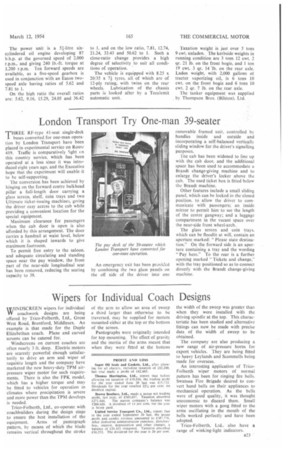London Transport Try One - man 39 - seater THREE RE-type 41-seat single-deck i
Page 57

If you've noticed an error in this article please click here to report it so we can fix it.
buses converted for one-man operation by London Transport have been placed in experimental service on Rout: 419. Traffic is comparatively light on this country service, which has been operated at a loss since it was introduced eight years ago, and the Executive hope that the experiment will enable it to be self-supporting.
The conversion has been achieved by hinging on the forward centre bulkhead pillar a full-length door carrying a glass screen, shelf, coin trays and two Ultimate ticket-issuing machine., giving the driver easy access to the cab while providing a convenient location for the special equipment.
Maximum clearance for passengers when the cab door is open is also afforded by this arrangement. The door carries a handrail at waist level, below which it is shaped inwards to give maximum footroom.
To permit free entry to the saloon, and adequate circulating and standing space near the pay window, the front part of the near-side longitudinal seat has been removed, reducing the seating capacity to 39. An emergency exit has been provided by combining the two glass panels on the off side of the driver into one removable framed unit, controlled by handles inside and outside and incorporating a self-balanced vertically sliding window for the driver's signalling purposes.
1 he cab has been widened to line up with the cab door, and the additional space has been used to accommodate a Brandt change-giving machine and to enlarge the driver's locker above the cab. The used ticket box is fitted below the Brandt machine.
Other features include a small sliding panel, which can be locked in the closed position. to allow the driver to communicate with passengers; an inside mirror to permit him to sec the length of the centre gangway; and a luggage compartment in the vacant space over the near-side front wheel-arch.
The glass screen and coin trays. which can be floodlit at will, contain an aperture marked: "Please state destination." On the forward side is an aperture containing a tray and the wording " Pay here." To the rear is a further opening marked "Tickets and change," with the tray positioned so as to connect directly with the Brandt change-giving machine,




































































































